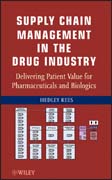
Supply chain management in the drug industry: delivering patient value for pharmaceuticals and biologics
Rees, Hedley
INDICE: PART I: SURVEYING AND MAPPING THE TERRITORY. CHAPTER 1 SETTING A TRANSFORMATIONAL AGENDA. 1.1 Aims and aspirations of the book. 1.2 Book Format. 1.3 Intended readership. 1.4 A book about two worlds in contrast. 1.5 The pharmaceutical lottery. 1.6 Supply Chain Management (SCM) in context. 1.7 The History of Supply and Value Generation. 1.8 The Development of Processes to Managethe Supply Chain. 1.9 Life in SCM. 1.10 Moving forward. CHAPTER 2 PLOTTING A COURSE TO PATIENT VALUE. 2.1 Why focus on Patient Value? 2.2 Where does the patient currently fit? 2.3 Why is it necessary to plot a course? 2.4 Understanding how the course is presently set. 2.5 Capturing value for patients. CHAPTER 3 PHARMACEUTICAL DRUG DEVELOPMENT. 3.1 Drug developments role in the supply chain. 3.2 Introduction to drug development. 3.3 The Medicinal Product. 3.4 Clinical Trials. 3.5 Related Development Programmes. 3.6 Managing Clinical Programs. 3.7 Regulatory Affairs and Authorities. 3.8 Supply Chain Management in Development Programmes. 3.9 Manufacture and Supply of Commercial Product. 3.10 Supply Chain Management for Commercial Product. CHAPTER 4 END-TO-END PHARMACEUTICAL SUPPLY CHAINS. 4.1 Where does responsibility for the supply chain lay? 4.2 Sponsor companies, license holders and their supply chains. 4.3 Supply chains for small molecule products. 4.4 Starting at the final destination. 4.5 How dodrugs enter the body? 4.6 Design of drug delivery systems. 4.7 What does thismean for the supply chain? 4.8 Key aspects of GMP/GDP in relation to SCM. 4.9An overview of the stages on route to patient delivery. 4.10 Manufacture and supply of biological entities. CHAPTER 5: WHY PHARMA SUPPLY CHAINS DONT PERFORM. 5.1 Supply chain underperformance. 5.2 Is there a case to answer? 5.3 Birthto infancy - the supply chain critical stage. 5.4 Commercial supply under thepatent protection umbrella. 5.4.1 Limited competitive alternatives. 5.4.2 Fragmentation. 5.4.3 Supplier power. 5.4.4 The position of those buying pharmaceutical products. 5.5 What does this mean for the pharmaceutical supply chain? PART II: BUILDING A KNOWLEDGE FOUNDATION IN SCM. CHAPTER 6 SUPPLY CHAIN MANAGEMENT AS A COMPETETIVE WEAPON. 6.1 Competition and business strategy. 6.2 The marketing mix. 6.3 Porters Five Forces. 6.4 Porters Generic Competitive Strategies. 6.5 Porters Value Chain. 6.6 Competitive strategy and customers. 6.7 The Japanese Experience. 6.8 Total Quality Management. 6.9 Lean Thinking. 6.10 Focusing on value for money. 6.11 SCM processes in competitive strategy. 6.12 SCM in biotech/virtual companies. 6.13 Competition in pharmaceuticals. CHAPTER 7 SUPPLY CHAIN MANAGEMENT (SCM) HOLISTIC. 7.1 The relevance of SCM to Pharmaceuticals. 7.2 Production systems and the holistic of SCM. 7.3 The Core of SCM. 7.4First principle of SCM. 7.5 Supply chains as a series of inter
- ISBN: 978-0-470-55517-0
- Editorial: John Wiley & Sons
- Encuadernacion: Cartoné
- Páginas: 456
- Fecha Publicación: 11/03/2011
- Nº Volúmenes: 1
- Idioma: Inglés
